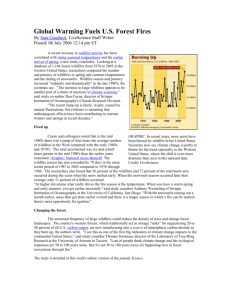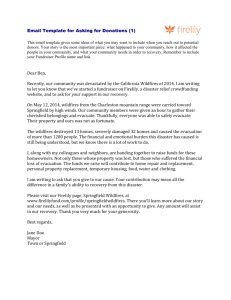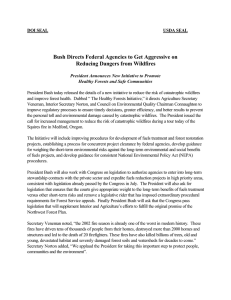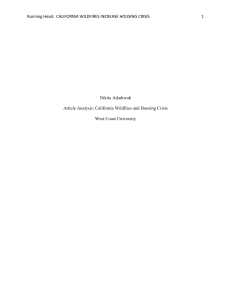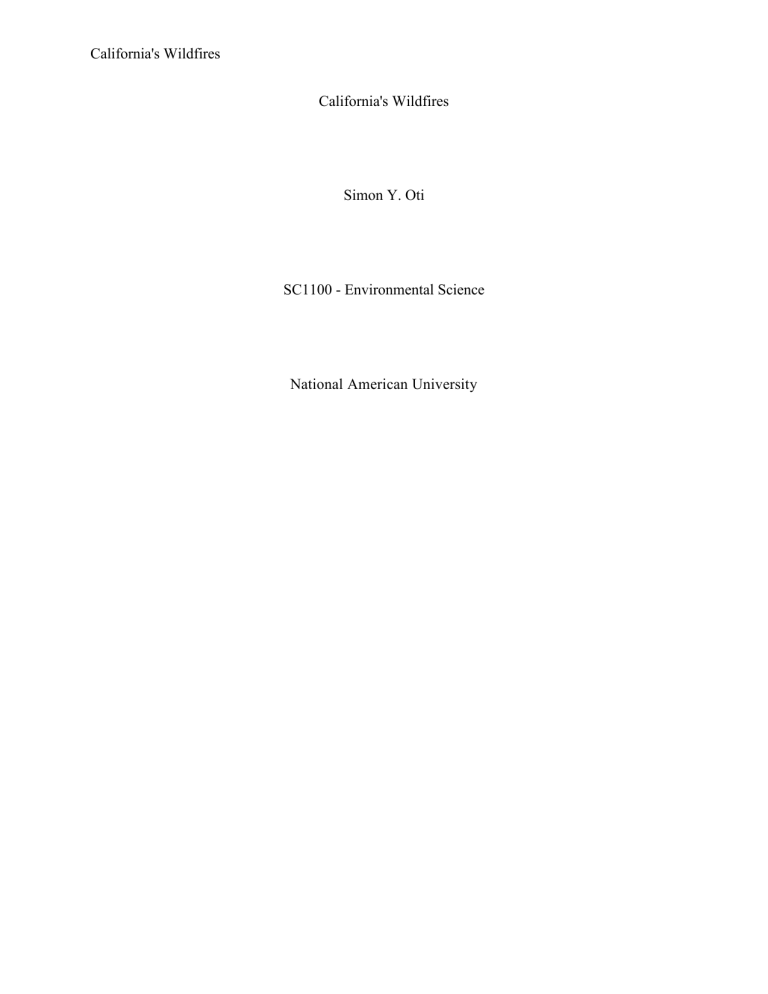
California's Wildfires California's Wildfires Simon Y. Oti SC1100 - Environmental Science National American University California's Wildfires California's Wildfires California wildfire has a very long history. It dates far back to the Pre-1800; most of the land was covered by shrub-land and forest. The ecology at that time was very resilient to the wildfire. California is often hot, dry, and windy, making it easy for the wildfire to spread quickly. Equipment that generates sparks like mowers and chainsaws, lightning, arsonists, and power lines have been the most common source of the California wildfires. The dry climate of California is also a substantial contributing factor to the wildfires. Human activities are one factor that cannot be overlooked when it comes to the cause of the California wildfires. Human activities have become a significant contributor to the majority of wildfires. I solidly believe there is a connection between the wildfires and mudslides in the pacific west. That is because; severe wildfires damage the forest canopy, the plants below, and the soil. This can result in an increased runoff after intense rainfall or rapid snowmelt, putting homes and other structures below a burned area at risk of localized floods and landslides (B.C. Ministry of Forests and Range, 2011. “As forests and hillsides are charred, damage to trees, plants, and the soil can create flooding and mudslides during a rainstorm. According to AccuWeather, plants roots help stabilize the soil. Intense heat from slow-moving fires can also make soil repel water” (ABC7 San Francisco, 2017). California's Wildfires Wildfires have a massive impact on the economy and the environment as a whole from property losses, Health Impacts, loss of lives, decreased tourism, and another big issue, the changes in the long-term structure of the local economy it brings. Wildfire causes air pollution. “Fires across the U.S. in 2019 caused about 3,700 civilian deaths and another roughly 17,000 injuries” (Nathan, 2021). Besides the significant emotional trauma of these deaths and injuries, they can also bring about local economies. Victims may be unable to work either permanently or for a while during recovery (Nathan, 2021). “Individuals close to a wildfire face dangers from breathing smoke, and significant wildfires can even negatively affect the air quality thousands of miles away. Even individuals not directly harmed in a fire may have health repercussions that affect their livelihood and healthcare needs” (Nathan, 2021). My suggestion for solving the wildfire problem is that people obey local laws regarding open fires, including campfires. Also, all flammable objects must be kept away from fire; Have firefighting tools nearby and handy; hot charcoal must be carefully disposed of. Dry leaves and vegetation should be kept away from properties, especially houses (Weeden, 2021). Recently, state and federal governmental entities have taken steps towards mitigating wildfires, increasing opportunities for companies selling and using woody byproducts. “On August 13, 2020, the State of California and the U.S. Forest Service signed the Agreement for Shared Stewardship of California’s Forest and Rangelands” (David Weber, 2020). The agreement is to help manage California’s woodland and forest lands to reduce the high risk of wildfires. That agreement entreats a coordinated effort between the U.S. Forest Service and California's Wildfires the California Natural Resource Agency to “increase the pace, scale, and effectiveness of forest and rangeland stewardship in California” (David Weber, 2020). In early August, Senators Steve Daines and Diane Feinstein introduced the Emergency Wildfire and Public Safety Act of 2020 (Wildfire Act). The wildfires in California are the main reason behind The Emergency Wildfire and Public Safety Act of 2020. The Wildfire Act would implement new fire mitigation projects, more proactive forest management plans, and create markets for timber on federal lands. The Wildfire Act would also lift the export ban on unprocessed timber from federal lands for dead or dying trees and create a grant program to remove biomass from National Forest areas and transport them to biomass conversion facilities (David Weber, 2020). The administrative and legislative initiatives are increasing in the west as the wildfires continuously increases. There are responses and mitigation measures federal, local, state and international agencies seeking to combat the situation every day. California's Wildfires References BC Ministry Of Forests And Range. (2011). 2011, Landslide and flooding risks after wildfires in British Columbia. For.Gov.Bc.Ca. https://www.for.gov.bc.ca/hfd/pubs/Docs/Bro/Bro91.htm David Weber, Kirstin Gruver. (2020, September 1). Wildfires Spark Forest Management Actions at State and Federal Levels, Opening Markets for Forest Management Byproducts. Beveridge & Diamond PC. https://www.bdlaw.com/publications/wildfires-spark-forestmanagement-actions-at-state-and-federal-levels-opening-markets-for-forest-managementbyproducts/ How wildfires create a serious threat for flooding and mudflows. (2018, November 19). ABC7 San Francisco. https://abc7news.com/wildfire-damage-tree-forest/2925492/ NATHAN REIFF. (2021, July 26). How Fire Season Affects the Economy. Investopedia. https://www.investopedia.com/how-fire-season-affects-the-economy-5194059 Weeden, M. (2021, May 27). 9 Ways to Prevent Wildfires in California. One Tree Planted. https://onetreeplanted.org/blogs/stories/ways-to-prevent-forest-fires
